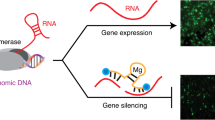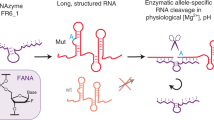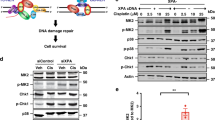Abstract
Peptide nucleic acid (PNA) oligomers are DNA mimics, which are capable of binding gene sequences 1000-fold more avidly than complementary native DNA by strand invasion and effectively obstruct transcription. Irreversibly obstructing the transcription or replication of a gene sequence, such as BRAFV600E, offers a potential route to specifically target the cancer cell itself. We have employed PNA oligomers to target BRAFV600E in a sequence-specific complementary manner. These PNAs have been modified by appending configurationally stabilizing cationic peptides in order to improve their cellular delivery and target avidity. Our results indicate that exposure of the melanoma cell lines to a modified PNA-peptide conjugate complementary to BRAFV600E mutation sequence results in a concentration-dependent and time-dependent inhibition of cell growth that is specific for the BRAFV600E-mutant melanoma cell lines with inhibition of mRNA and protein expression. Xenograft mouse trials show increased tumor growth delay and necrosis with the BRAFV600E-complementary PNA-peptide conjugates as compared with the saline and scrambled PNA sequence controls. Similarly, quantitative measurement shows a 2.5-fold decrease in Ki67 and a 3-fold increase in terminal deoxynucleotidyl transferase dUTP nick end labeling expression with this approach. PNA-delivery peptide conjugates represent a novel way to target BRAFV600E and represent a new approach in targeting selective oncogenes that induce tumor growth.
This is a preview of subscription content, access via your institution
Access options
Subscribe to this journal
Receive 12 print issues and online access
$259.00 per year
only $21.58 per issue
Buy this article
- Purchase on Springer Link
- Instant access to full article PDF
Prices may be subject to local taxes which are calculated during checkout





Similar content being viewed by others
References
Zhao Y, Wang W, Min I, Wyrwas B, Moore M, Zarnegar R et al. BRAF V600E-dependent role of autophagy in uveal melanoma. J Cancer Res Clin Oncol 2017; 143: 447–455.
Janssen CS, Sibbett R, Henriquez FL, McKay IC, Kemp EG, Roberts F . The T1799A point mutation is present in posterior uveal melanoma. Br J Cancer 2008; 99: 1673–1677.
Robert C, Karaszewska B, Schachter J, Rutkowski P, Mackiewicz A, Stroiakovski D et al. Improved overall survival in melanoma with combined dabrafenib and trametinib. N Engl J Med 2015; 372: 30–39.
Long GV, Stroyakovskiy D, Gogas H, Levchenko E, de Braud F, Larkin J et al. Dabrafenib and trametinib versus dabrafenib and placebo for Val600 BRAF–mutant melanoma: a multicentre, double-blind, phase 3 randomised controlled trial. Lancet 2015; 386: 444–451.
Larkin J, Ascierto PA, Dréno B, Atkinson V, Liszkay G, Maio M et al. Combined vemurafenib and cobimetinib in BRAF-mutated melanoma. N Engl J Med 2014; 371: 1867–1876.
Iams WT, Sosman JA, Chandra S . Novel targeted therapies for metastatic melanoma. Cancer J 2017; 23: 54–58.
Wilson MA, Guld K, Galetta S, Walsh RD, Kharlip J, Tamhankar M et al. Acute visual loss after ipilimumab treatment for metastatic melanoma. J Immunother Cancer 2016; 4: 66.
Weber JS . Practical management of immune-related adverse events from immune checkpoint protein antibodies for the oncologist. Am Soc Clin Oncol Educ Book 2012: 174–177.
Izzedine H, Gueutin V, Gharbi C, Mateus C, Robert C, Routier E et al. Kidney injuries related to ipilimumab. Invest New Drugs 2014; 32: 769–773.
Sharma P, Retz M, Siefker-Radtke A, Baron A, Necchi A, Bedke J et al. Nivolumab in metastatic urothelial carcinoma after platinum therapy (CheckMate 275): a multicentre, single-arm, phase 2 trial. Lancet Oncol 2017; 18: 312–322.
Larkin J, Lao CD, Urba WJ, McDermott DF, Horak C, Jiang J et al. Efficacy and safety of nivolumab in patients with BRAF V600 mutant and BRAF wild-type advanced melanoma: a pooled analysis of 4 clinical trials. JAMA Oncol 2015; 1: 433–440.
D’Angelo SP, Larkin J, Sosman JA, Lebbé C, Brady B, Neyns B et al. Efficacy and safety of nivolumab alone or in combination with ipilimumab in patients with mucosal melanoma: a pooled analysis. J Clin Oncol 2017; 35: 226–235.
Hyrup B, Nielsen PE . Peptide nucleic acids (PNA): synthesis, properties and potential applications. Bioorg Med Chem 1996; 4: 5–23.
Peffer NJ, Hanvey JC, Bisi JE, Thomson SA, Hassman CF, Noble SA et al. Strand-invasion of duplex DNA by peptide nucleic acid oligomers. Proc Natl Acad Sci USA 1993; 90: 10648–10652.
Cutrona G, Carpaneto EM, Ponzanelli A, Ulivi M, Millo E, Scarfì S et al. Inhibition of the translocated c-myc in Burkitt’s lymphoma by a PNA complementary to the Eμ enhancer. Cancer Res 2003; 63: 6144–6148.
Tonelli R, Purgato S, Camerin C, Fronza R, Bologna F, Alboresi S et al. Anti-gene peptide nucleic acid specifically inhibits MYCN expression in human neuroblastoma cells leading to cell growth inhibition and apoptosis. Mol Cancer Ther 2005; 4: 779–786.
Cogoi S, Codognotto A, Rapozzi V, Meeuwenoord N, van der Marel G, Xodo LE . Transcription inhibition of oncogenic KRAS by a mutation-selective peptide nucleic acid conjugated to the PKKKRKV nuclear localization signal peptide. Biochemistry 2005; 44: 10510–10519.
Yu X, Ambrosini G, Roszik J, Eterovic AK, Stempke-Hale K, Seftor EA et al. Genetic analysis of the ‘uveal melanoma’ C918 cell line reveals atypical BRAF and common KRAS mutations and single tandem repeat profile identical to the cutaneous melanoma C8161 cell line. Pigment Cell Melanoma Res 2015; 28: 357–359.
Tatsuno M, Shioda Y, Iwafuchi H, Yamazaki S, Iijima K, Takahashi C et al. BRAF V600 mutations in Langerhans cell histiocytosis with a simple and unique assay. Diagnostic Pathol 2016; 11: 39.
White PD, Chan WC Basic procedure In: Chan WC, White PD (eds) Fmoc Solid Phase Peptide Synthesis. Oxford University Press Inc: New York, 2000 p 41.
Chaubey B, Tripathi S, Pandey VN . Single acute-dose and repeat-doses toxicity of anti-HIV-1 PNA TAR-penetratin conjugate after intraperitoneal administration to mice. Oligonucleotides 2008; 18: 9–20.
Zhang X, Ishihara T, Corey DR . Strand invasion by mixed base PNAs and a PNA–peptide chimera. Nucleic Acids Res 2000; 28: 3332–3338.
Wang G, Xu X, Pace B, Dean DA, Glazer PM, Chan P et al. Peptide nucleic acid (PNA) binding-mediated induction of human γ-globin gene expression. Nucleic Acids Res 1999; 27: 2806–2813.
Zelphati O, Liang X, Nguyen C, Barlow S, Sheng S, Shao Z et al. PNA-dependent gene chemistry: stable coupling of peptides and oligonucleotides to plasmid DNA. Biotechniques 2000; 28: 304–310 312-314, 316.
Acknowledgements
This study was supported by the ASCO Young Investigator Award 2010 for Jeffrey Rothman, Tech Development Office Seed Fund from Memorial Sloan Kettering Cancer Center and Columbia University Medical Center. We also thank Ouathek Ouerfelli for his scientific advice and material support on this project.
Author information
Authors and Affiliations
Corresponding author
Ethics declarations
Competing interests
The authors declare no conflict of interest.
Additional information
Supplementary Information accompanies the paper on Cancer Gene Therapy website
Rights and permissions
About this article
Cite this article
Rothman, J., Surriga, O., de Stanchina, E. et al. Obstruction of BRAFV600E transcription by complementary PNA oligomers as a means to inhibit BRAF-mutant melanoma growth. Cancer Gene Ther 24, 401–408 (2017). https://doi.org/10.1038/cgt.2017.34
Received:
Accepted:
Published:
Issue Date:
DOI: https://doi.org/10.1038/cgt.2017.34
This article is cited by
-
Functions of MAP3Ks in antiviral immunity
Immunologic Research (2023)



